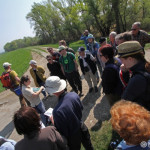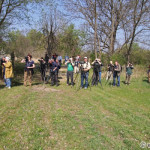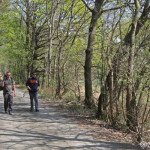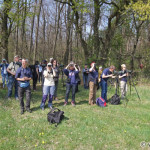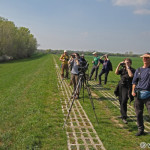Austrian visit of the Slovak green belt
Monday, April 7, 2014
As a part of Pannonian Bird Experience 2014 – the central European Birdfair – we prepared a guided trip to site called Devínske jazero. It is a regularly flooded area of the Morava River, part of the Protected Landscape Area Záhorie, to the north-west from Bratislava. Only a few decades ago, this was a strictly guarded border zone. Only residents of nearby villages could use public roads and no one was allowed to approach the river. Austrians and Slovaks only seldom visited the other country and if yes, than everything was strictly regulated and supervised.
A beautiful sunny day was ahead of us, when we set of Illmitz at 10 am. Our bus drove us to the very edge of the protected area. At first we informed the participants about the site: its history, conservation status and bird species occurring here. As our trip was predominantly focused on birds of prey, our eyes were set up to the sky. Only a few minutes passed and we saw our first raptor – majestic Imperial Eagle (Aquila heliaca). Devínske jazero is a regular feeding ground of this impressive bird. We moved on along the bike path. We made several stops at places with a good view on the whole area. From these we saw Red and Black Kite (Milvus milvus, M. migrans) and White Stork (Ciconia ciconia). Above our heads circled Common Buzzards (Buteo buteo). In the trees surrounding the path we could hear and also see many species of song birds, such as typical Chaffinches, Chiffchaffs, Yellowhammers and Greenfinches. We heard also several woodpeckers and a part of our group observed also one Middle Spotted Woodpecker (Dendrocopos medius). Then we got back to the bus and walked along the dike to see the area from another perspective. We observed Red Kites and Buzzards again.
It was really a pleasant day in a company of very nice people and we enjoyed it much. We hope we will see each other again!
.
The list of observed species:
Common Pheasant (Phasianus colchicus)
Mute Swan (Cygnus olor)
Mallard (Anas platyrhynchos)
Black Stork (Ciconia nigra)
Grey Heron (Ardea cinerea)
Great Cormorant (Phalacrocorax carbo)
Red Kite (Milvus milvus)
Black Kite (Milvus migrans)
Common Buzzard (Buteo buteo)
Eastern Imperial Eagle (Aquila heliaca)
Common Kestrel (Falco tinnunculus)
Lapwing (Vanellus vanellus)
Black-headed Gull (Chroicocephalus ridibundus / Larus ridibundus)
Feral Pigeon (Columba livia)
Middle Spotted Woodpecker (Dendrocopos medius / Picoides medius)
Great Spotted Woodpecker (Dendrocopos major / Picoides major)
Black Woodpecker (Dryocopus martius)
Green Woodpecker (Picus viridis)
Common Magpie (Pica pica)
Hooded Crow (Corvus cornix)
Great Tit (Parus major)
Blue Tit (Cyanistes caeruleus / Parus caeruleus)
Common Skylark (Alauda arvensis)
Willow Warbler (Phylloscopus trochilus)
Chiffchaff (Phylloscopus collybita)
Blackcap (Sylvia atricapilla)
Wren (Troglodytes troglodytes)
Nuthatch (Sitta europaea)
Common Starling (Sturnus vulgaris)
Blackbird (Turdus merula)
Song Thrush (Turdus philomelos)
Robin (Erithacus rubecula)
White Wagtail (Motacilla alba)
Chaffinch (Fringilla coelebs)
Serin (Serinus serinus)
Greenfinch (Carduelis chloris / Chloris chloris)
Goldfinch (Carduelis carduelis)
Yellowhammer (Emberiza citrinella)



